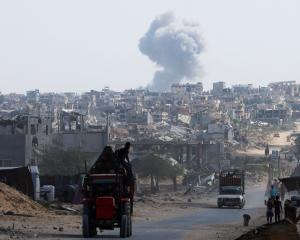Is New Zealand a peace-maker or arms exporter, asks Peter Matheson.
We like to think of New Zealand as a peace-loving nation, championing a nuclear-free and independent Pacific, and using our professional skills as in recent times as peace-keepers.
In the Solomons, for example, after communal hostilities in 1998-2003 had seen 100 deaths and about 40,000 people driven from their homes, we moved in successfully at the request of the Solomon Island government.
Together with Australian police and military forces, peace was restored. We have also put our name to various international agreements to limit the arms trade.
It comes, therefore, as a shock to learn that our Government is now actively engaged in promoting a growing New Zealand arms industry; that we are busily expanding our exports of arms to countries such as Saudi Arabia, currently waging a deadly campaign in Yemen.
How many of us know that more than 250 New Zealand companies are currently involved in the provision of weapons, other military hardware and services, and that all this comes with the active involvement of Government?
Many of the New Zealand firms involved, such as Lockheed Martin, Babcock, Rakon, SAAB and Tactical Solutions, are New Zealand subsidiaries of huge overseas armaments manufacturers.
An imminent arms conference in Auckland highlights these developments. Defence Minister Gerry Brownlee will front up as one of the main speakers at the so-called NZ Defence Industry Forum at the Viaduct Events Centre tomorrow and Thursday.
The conference, which is basically an arms fair, is co-sponsored by the Government and giant overseas armaments manufacturers, companies such as Lockheed Martin, which are here to lobby for government contracts. (Currently, Lockheed Martin is carrying out a $446million upgrade of our frigates.)
The focus of the arms fair is on exhibiting arms and exchanging information about new technological advances. Admission to the conference is restricted to registered delegates, each paying $480.
The arms fair coincides with the celebration of the New Zealand navy's 75th anniversary, dubbed Operation Neptune. A total of 30 navies have been invited to participate, including a United States warship, culminating in their crews marching through Auckland streets.
This gaudy arms fair seems an odd way to celebrate Remembrance Day.
It certainly raises some serious questions. Have we just drifted into this? Is the trade and exporting tail of Government wagging the political dog? Is our foreign policy, our commitment to world peace and justice, compromised by chasing the dollar in this fashion?
As an Auckland Presbyterian minister, the Rev Stuart Vogel, has commented, is there not something obscene about this promotion of arms sales as we read each day of the carnage in Syria, Iraq, and elsewhere?
Auckland community organisation Splice, which does so much for creating good relationships in inner-city Auckland, is also appalled. Its chaplain, another Presbyterian minister, John McDonald, has expressed his dismay in his blog.
The inner-city Auckland churches are participating in a peace walk to protest at this arms fair.
There are to be protests in Wellington and a peace service was held in Knox Church by Dunedin's inner-city churches on Sunday.
But most New Zealanders have no idea of what is going on. No wonder. It is difficult to get full information about the extent of arms exports, and requests through the Official Information Act tend to fall on deaf ears.
The respected Stockholm International Peace Research Institute does provides some accurate information.
Government involvement is certainly ongoing and enthusiastic. Annual awards are made to the best defence contractor. NZ Trade and Enterprise (NZTE) sends staff overseas to meet arms manufacturers and encourage New Zealand exports. NZTE also sponsors trade stalls overseas.
Tait Electronics, in Christchurch, receives substantial grants through the Callaghan Innovation Fund, well over $10million; Cubic Defence, a subsidiary of the US Cubic Corporation which supplies US and Israeli armed forces, also receives substantial grants.
Our arms exports go currently to a variety of countries, including the US, Australia, Bahrain, Egypt, Saudi Arabia, the United Arab Emirates and Qatar.
They include computers to control artillery and mortar fire, radio equipment, components for missile guidance and drones, transport vehicles, HamiltonJet engines, and ammunition.
It is not possible to put a figure on this, but $200million has been mentioned. If so, this is still pretty small beer, and one wonders if we have thought this through, politically, not to mention morally? Is the game worth the candle? How have we got into touting for exports in the deadly business of arms? What does it do for our international image?
How does the close collaboration of our Government with these massive multinational arms manufacturers square with our commitment to a free and independent Pacific and to our role in the UN?
Is this gaudy arms fair, plus a triumphalist march through Auckland, an appropriate way of remembering the sickening horror of two world wars?
-Peter Matheson is a Dunedin historian.









